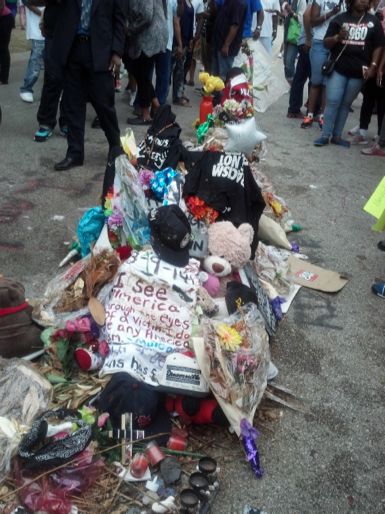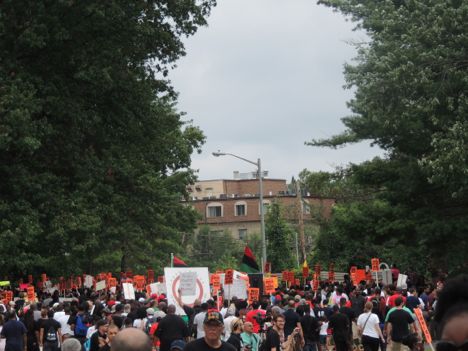“Can’t be revolution without women, can’t be revolution without children”*
On August 28, six of us from Syracuse joined other Black organizers, cultural workers, healers, etc. from all across the country for a weekend of national action in Ferguson. According to the organizers, “the Black Life Matters Ride” was organized in the spirit of the early 1960s interstate Freedom Rides to end racial segregation. Armed with the spirit and knowledge of the radical Black Freedom tradition, when the Black Lives Matter group put out the national call to be in Ferguson, my friends and I knew we had to answer.

The March
We arrived in Ferguson on Saturday, the day of the National March. The gray skies and thick clouds that hung low above our heads seemed to capture our collective state of grieving and mourning, not just for Mike Brown, but for the countless other Black people mercilessly killed at the hands of the state. We walked down West Florissant, one of the main streets in town, to get to the starting place of the march. West Florissant was lined with a number of plazas and stores, and some of the boarded up stores had messages thanking people for the love and support of Ferguson.
The march started on the corner of West Florissant Street and a much smaller street, Canfield Drive. Five hundred people marched down Canfield Drive, young, old, predominantly Black with a smattering of white faces chanting “hands up don’t shoot!” As we were marching down Canfield Drive, the street began to narrow and I realized we were actually marching in a residential neighborhood. It seemed odd to me that we would march in this small community, rather than march down West Florissant, a much broader and busier street that would have certainly increased visibility. We eventually stopped and the Fruit of Islam, the defense wing of the Nation of Islam, the Black Muslim religious and political organization, told everyone to get on the sidewalk. My friends who were further up in the march told me that we were actually standing in the place where Mike Brown was killed. After people began moving to the sidewalk, I then saw the memorial filled with caps, teddy bears, t-shirts, and all sorts of trinkets and tokens of love for Mike Brown. He was somebody’s son, someone’s neighbor, someone’s friend. Mike Brown was somebody. A human being.
I had a difficult time making sense of where we were because none of the photos and reports I’d seen up to that point had captured the intimacy of the street and the neighborhood where Mike Brown was gunned down as if he were mere prey. In that moment, I realized that Darren Wilson not only had no regard for Mike Brown’s life but he obviously had no respect for the lives of anyone in that community. Apartments were at the edge of the narrow street, and as my friend Sherri pointed out, those gun shots could have easily gone into someone’s home. It also made it that much more repulsive and vile that police left Mike Brown’s dead body in the street for four hours. How traumatic and harrowing it must have been to have Wilson shooting in such a closed space, and then leaving a young boy’s body in the street for all of the community to see. This further solidified to me that Black people are not even safe in what are supposed to be the most sacred spaces in our society; our homes and our communities.
The Black Lives Matter organizers made a concerted effort to amplify the voices and the work of Black women and Black youth organizers in Ferguson, and the importance of this cannot be stressed enough. After the March on Saturday, we were invited to a BBQ that was put together mainly by women and youth in the community. One woman told us about the efforts of a dedicated a group of local teens that started a collective called LostVoices. She told us that these teens camped out at a local church, hardly getting any sleep for at least 10 days straight as they were collecting and distributing vital supplies such as food and water for the protesters and community members. They had also been holding demonstrations, protests, voter registration drives, amongst other important political activities as well. Their commitment to fighting for justice has been absolutely unwavering.
Later that evening, we heard from three young Black women that had been working tirelessly since August 9th, the day Mike Brown was killed. They also had been collecting and distributing supplies for fellow protestors and activists. Additionally, when the protests erupted in Ferguson, these women strategically used social media to actually let people know what was happening on the ground and to highlight their own experiences with being beaten and tear gassed. One of the women remarked that the police had absolutely no qualms with beating, tear gassing and brutalizing women. This was such an important point because far too often, conversations about police brutality usually focus on cisgender heterosexual Black men, to the exclusion of Black women, trans members of the Black community, and queer members as well. This was an important reminder, that any fight for racial justice must be unapologetically intersectional and inclusive.

St. John’s United Church, a local church, was gracious enough to host us throughout the weekend, so on Sunday, our final day there, they invited us to a special sermon that connected the politics of Jesus to the struggle in Ferguson. Reverend Starsky Wilson’s earth-moving inspirational message argued that the political climate of Jesus’ time was similar to our own and that we need radical and revolutionary resistance to fight occupation, militarism, racism, and bigotry. The church filled with thunderous applause, foot stomping, and shouting from believers and non-believers alike. After the sermon, a 10-year-old girl from California gave a heart-wrenching testimony about her fears of being gunned down by a police officer while playing outside with her friends and how it was this fear for her life and her own safety that compelled her to come to Ferguson so she can have the future she knows she deserves. On the one hand it was absolutely devastating to hear a 10 year old express her fears about the reality of living in a white supremacist society that has no regard for her life or the lives of other Black children, but on the other hand, it was inspiring to hear that even 10 year olds have a profound and deep commitment to fighting for justice.
We would do well to remember these stories of courage and commitment in Ferguson when racist and/or opportunistic talking heads try to demonize and criminalize Black people for actively fighting for a world and a society where Black lives do indeed matter.
* Lyric from hip hop group Arrested Development’s song “Mama’s Always on Stage.”





